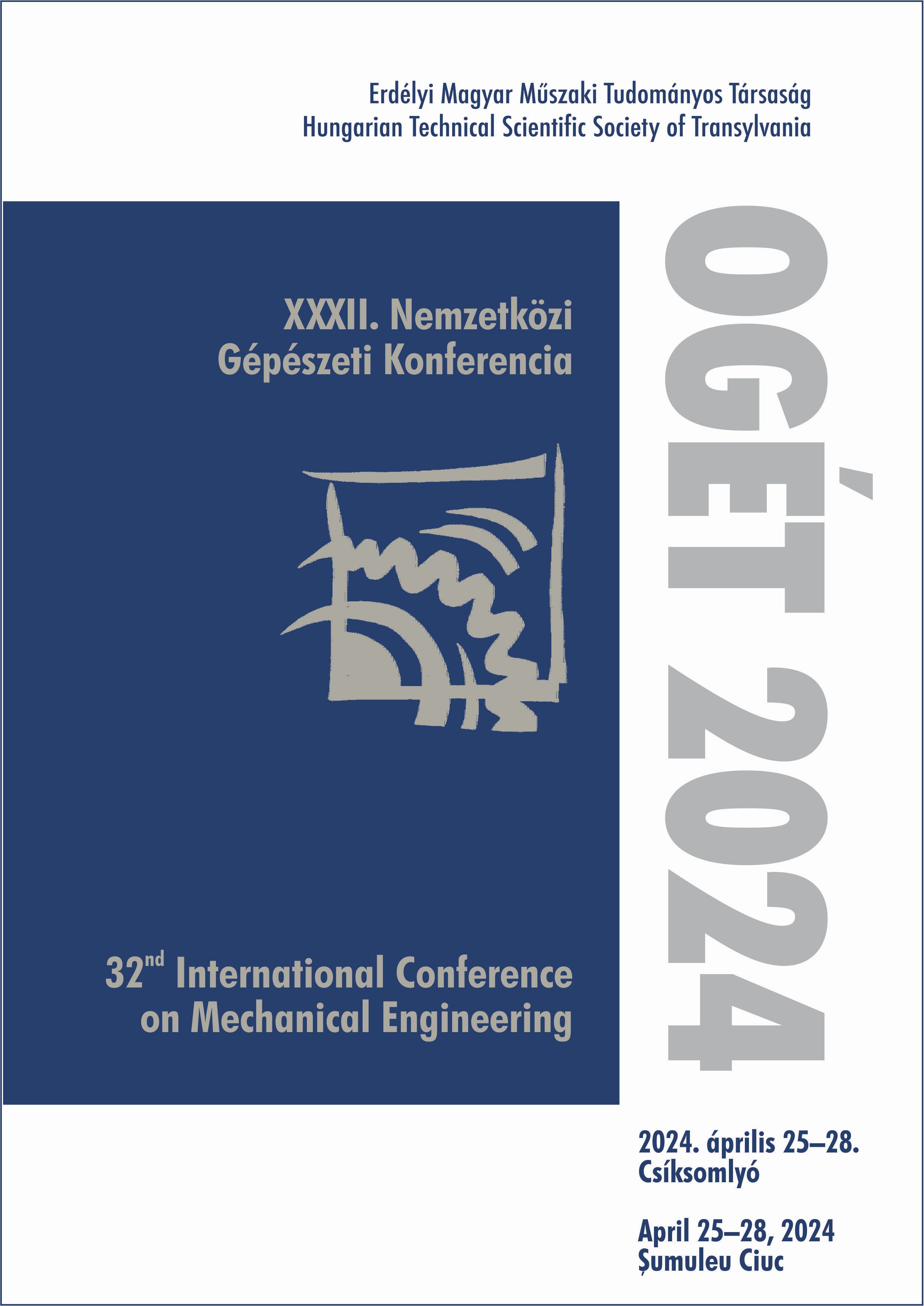Térhálós epoxy gyanta forgácsolhatósági vizsgálata hosszesztergálási kísérletekkel
Machinability analysis of thermosetting epoxy resin through turning experiments
Keywords:
Machinability, Turning, Polymer cutting, Cutting force, Surface Roughness, /, Forgácsolhatóság, Esztergálás, Polimer forgácsolás, Forgácsolási erő, Felületi érdességAbstract
Thermosetting polymers are popularly used as matrix materials for high-strength fibre-reinforced polymer (FRP) composite structures. Machining these FRP composites is often necessary, but their machining technology planning is challenging. In order to support the machining technology planning of FRP composites, we investigated the machinability of thermosetting epoxy resin with turning experiments in this research. The feed rate, cutting speed, and depth of cut varied based on a two-level full factorial experimental design. The cutting force was measured with a KISTLER 9263A three-component dynamometer. The quality of the machined surface was examined with a Mitutoyo SJ400 contact profilometer. The significance of the main and cross effects was examined using analysis of variance (ANOVA). Based on the ANOVA results, all three investigated factors significantly affect the cutting force and surface quality, so the careful selection of these factors is of cardinal importance.
Kivonat
A térhálós polimereket előszeretettel alkalmazzák a nagyszilárdságú szálerősített polimer (FRP) kompozit szerkezetek mátrixanyagaként. Ezen FRP kompozitok forgácsolása sokszor szükséges, azonban forgácsolástechnológiai tervezésük bonyolult. Az FRP kompozitok forgácsolástechnológiai tervezésének támogatása érdekében ebben a kutatásban térhálós epoxy gyanta forgácsolhatóságát vizsgáltuk hosszesztergálási kísérletekkel. Az előtolást, a forgácsolási sebességet és a fogásmélységet variáltuk kétszintes teljes faktoriális kísérletterv alapján. A forgácsolási erőt egy KISTLER 9263A háromkomponenses erőmérővel mértük. A forgácsolt felület minőségét egy Mitutoyo SJ400 típusú kontakt profilométerrel vizsgáltuk. A fő- és kereszthatások szignifikanciáját varianciaanalízissel (ANOVA) értékeltük ki. Az ANOVA eredmények alapján mindhárom vizsgált faktornak szignifikáns hatása van a forgácsolási erőre és a felület minőségére is, így ezen faktorok körültekintő megválasztása kardinális fontosságú
References
Geier N, Paulo Davim J, Szalay T. Advanced cutting tools and technologies for drilling carbon fibre reinforced polymer (CFRP) composites: a review. Composites Part A: Applied Science and Manufacturing 2019;125:105552. https://doi.org/10.1016/j.compositesa.2019.105552.
Czigány T. Special manufacturing and characteristics of basalt fiber reinforced hybrid polypropylene composites: Mechanical properties and acoustic emission study. Composites Science and Technology 2006;66:3210–20. https://doi.org/10.1016/j.compscitech.2005.07.007.
Czél G. Development of bi-directional pseudo-ductile glass/carbon-epoxy hybrid composites for improved safety in structural applications. Composites Part B: Engineering 2022;231:109546. https://doi.org/10.1016/j.compositesb.2021.109546.
Abrão AM, Faria PE, Rubio JCC, Reis P, Davim JP. Drilling of fiber reinforced plastics: A review. Journal of Materials Processing Technology 2007;186:1–7. https://doi.org/10.1016/j.jmatprotec.2006.11.146.
Sauer K, Hertel M, Fickert S, Witt M, Putz M. Cutting parameter study of CFRP machining by turning and turn-milling. Procedia CIRP 2020;88:457–61. https://doi.org/10.1016/j.procir.2020.05.079.
Abhishek K, Datta S, Mahapatra SS. Optimization of MRR, Surface Roughness, and Maximum Tool-Tip Temperature during Machining of CFRP Composites. Materials Today: Proceedings 2017;4:2761–70. https://doi.org/10.1016/j.matpr.2017.02.154.
Xu J, An Q, Cai X, Chen M. Drilling machinability evaluation on new developed high-strength T800S/250F CFRP laminates. Int J Precis Eng Manuf 2013;14:1687–96. https://doi.org/10.1007/s12541-013-0252-2.
Alauddin M, Choudhury IA, El Baradie MA, Hashmi MSJ. Plastics and their machining: A review. Journal of Materials Processing Technology 1995;54:40–6. https://doi.org/10.1016/0924-0136(95)01917-0.
Xiao KQ, Zhang LC. The role of viscous deformation in the machining of polymers. International Journal of Mechanical Sciences 2002;44:2317–36. https://doi.org/10.1016/S0020-7403(02)00178-9.
Gubbels GPH. Diamond turning of glassy polymers. Phd Thesis 1 (Research TU/e / Graduation TU/e). Technische Universiteit Eindhoven, 2006. https://doi.org/10.6100/IR613637.
Ahmad J. Machining of Polymer Composites. Springer US; 2009.
Ashworth S, Fairclough JPA, Sharman ARC, Meredith J, Takikawa Y, Scaife R, et al. Varying CFRP workpiece temperature during slotting: Effects on surface metrics, cutting forces and chip geometry. Procedia CIRP 2019;85:37–42. https://doi.org/10.1016/j.procir.2019.09.021.
Jia Z, Fu R, Wang F, Qian B, He C. Temperature effects in end milling carbon fiber reinforced polymer composites. Polymer Composites 2018;39:437–47. https://doi.org/10.1002/pc.23954.
Geier N, Pereszlai C. Analysis of characteristics of surface roughness of machined CFRP composites. Periodica Polytechnica 2020;64:67–80. https://doi.org/10.3311/PPme.14436.
Palásti-Kovács B, Sipos S, Czifra Á. 'Rz=4xRa’ and other roughness parameters in the evaluation of machined surfaces. 13th International Conference on Tools Miskolc 2012.


